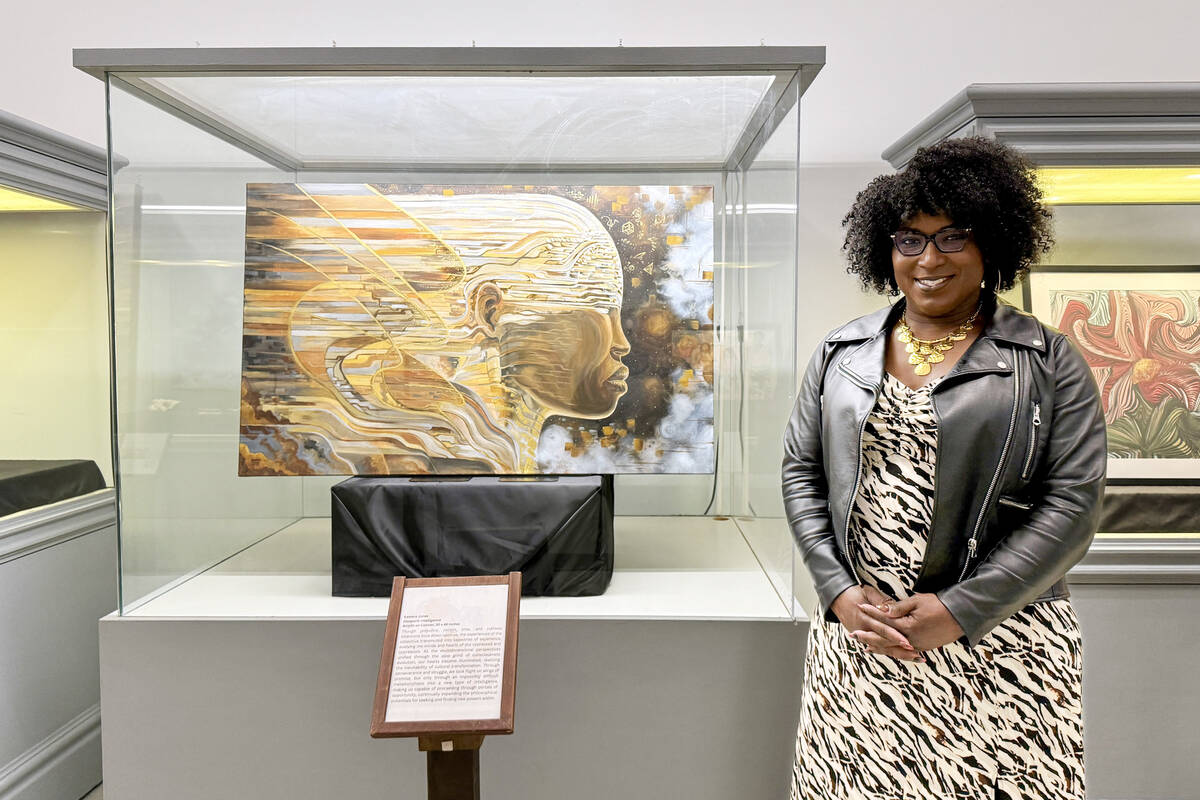Museum honors Black History Month with ‘Resilience’ exhibit

Amid the Las Vegas Natural History Museum displays telling the stories of desert wildlife, prehistoric mammals and more is an exhibit that will only be shown through the end of February.
The museum is hosting “Resilience,” a collection of artwork and poetry by local African American artists that will remain on display during Black History Month.
The exhibit’s title is an especially appropriate word to describe artist Kamora Jones’ artwork now on display and to describe Jones herself.
For Jones, the “Resilience” exhibit “represents the desire for the artist to express how they feel in American bodies as descendants of Africa, and how they can express that through their creative vision and their creative skills.”
That, she said, is a big deal.
“Nowadays, it’s really hard to be individualistic or creative anymore without somebody telling you that you’re not being realistic or you’re not being logical,” Jones said. “And so that ability to put it in a visual form, or in a written form, is a really great way to talk about the many dimensions of how one may think about who we’ve become as black people, as black Americans,” she said.
“We are not Africans, (and) although the term African American still applies, we’re definitely Black Americans,” she said.
“And so what does that mean? We’re in a very different age now, lots going on in the media,” she said. “And so artists expressing that is, is one portal through which we can understand the current paradigm of black thought.”
On a recent weekday, Jones stood in front of an acrylic painting she calls “Diasporic Intelligence.” It features a black woman, her hair streaming behind her while she stares sternly toward what looks like the cosmos.
Jones, 46, a longtime casino game designer for Las Vegas-based Light & Wonder, said she started to draw at age 3, later studied painting and drawing at the Las Vegas Academy of the Arts in downtown Las Vegas and then received a degree at the Art Institute of Colorado in Denver where she studied media arts and animation.
‘Carried on into this sort of new consciousness’
She talked about how the artwork touches on ideas within the context of the progression of Black life in America since their forced transfer from Africa due to slavery.
“So the piece expressed this idea that we are carried on into this sort of new consciousness,” Jones said. “And so in black culture, there’s a lot of talk about double consciousness: this idea that you come from one place, but you have to express yourself in a completely different way to be palatable.”
She explains further that, “The idea is that people who migrated from Africa, albeit through slavery, or through just migrating in general, changed culture and transmitted that culture into something very different, which is American culture.
“Now, I don’t see myself as an African, I am definitely an American,” the artist added. “But my blood in my cells holds that trauma of the African Diaspora, of that movement, of that migration.”
Much of her art is “very metaphysical,” she explained.
“It expresses the unseen, this idea of the spiritual, the soul, the consciousness, the connection with higher consciousness,” she said.
‘Spiritual symbolism’
Jones said she then gives visualization to the art.
”And so I do that through spiritual symbolism, like wings and like energy and like cells and mathematical constructs that express the distance and the proximity of one type of energy to another,” she said.
The suggestion of a woman in the cosmos and the flowing lines in “Diasporic Intelligence,” Jones said, is “sort of like data, like a flow of data, all the information that over time has sort of accumulated.”
“And so it’s going all the way back to this sort of inception of that beginning point of movement into who we are now,” she said. “And so everyone gets to collect that. Everyone gets to jack into that data, and we get to use that data to, to move, to walk, to fly, to transpire in the moment and for the future.”
“And that’s not just, you know, Black people. That’s everyone,” she said.
“We’re all using technology, and we’re all using our understanding of math and physics,” Jones said. “We’re learning more about the world. We’re learning more about society, and we’re learning that through education, some of the old ways, some of the old religious ways, have helped us, from a philosophical standpoint to understand how we relate to the world, culturally, and tribally. But we’re growing, we’re moving, we’re evolving.
“And so I’m trying to express that through my art.”
If you want to go
The “Resilience” exhibit will be on display at the museum, 900 Las Vegas Blvd. North, through Feb. 29 and is included in a museum admission or membership.
Also, at 11 a.m. and 1 p.m. Saturdays through the month, Ghanaian African dance performer Harold Akyeampong, with the Nevada Arts Council, will host workshops highlighting the global impact of African music styles, using non-Western instruments, according to a museum news release.
For more information, visit www.lvnhm.org,
Contact Jeff Burbank at jburbank@reviewjournal.com or 702-383-0382. Follow him @JeffBurbank2 on X.